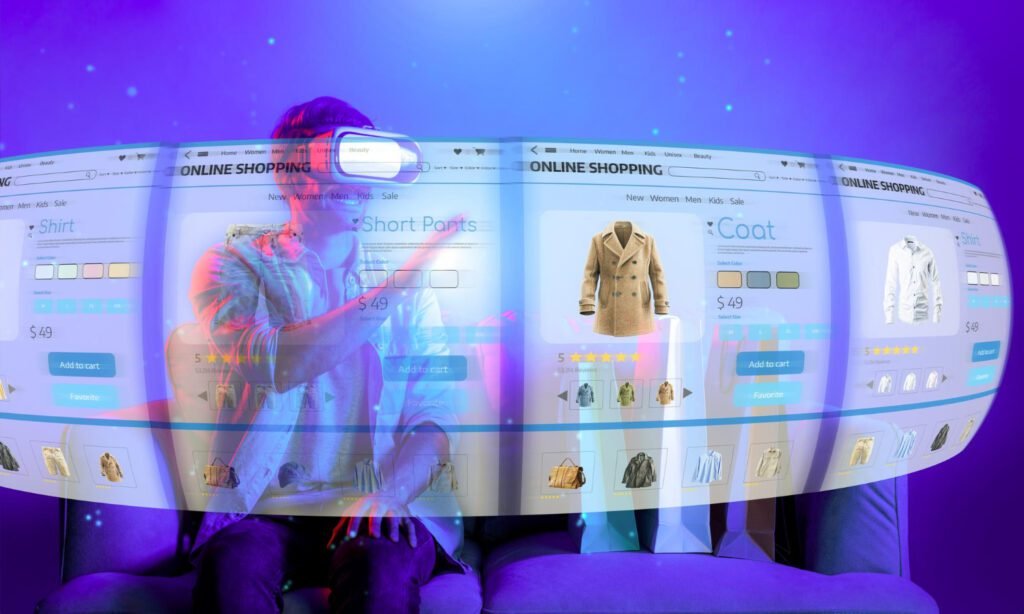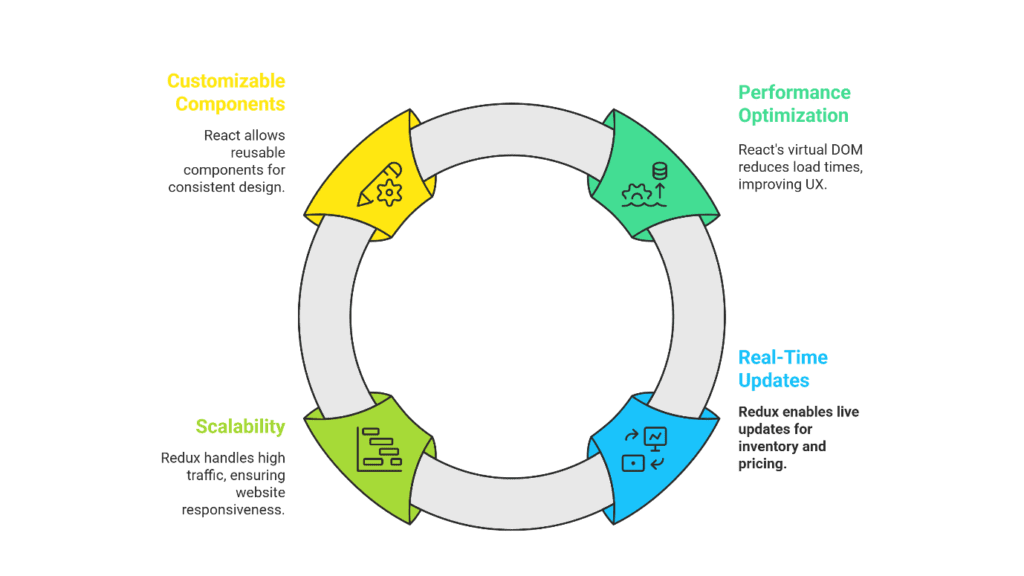

Introduction
I n today’s fast-paced digital marketplace, a seamless user experience (UX) is the backbone of successful e-commerce websites. Customers expect quick load times, real-time updates, and intuitive interactions. Tools like React and Redux empower developers to meet these demands by creating dynamic, scalable, and efficient applications. This article explores how React and Redux enhance e-commerce UX, with practical insights, real-world examples, and actionable best practices for developers.
1. The Importance of Seamless User Experience in E-Commerce
A smooth UX directly influences customer satisfaction, retention, and conversion rates. Studies show that 88% of online shoppers are less likely to return to a site after a negative experience, and a 1-second delay in page load time can result in a 7% reduction in conversions.
E-commerce platforms must prioritize fast, responsive, and consistent interfaces to keep users engaged.
React and Redux play a critical role in achieving this. React, a JavaScript library for building user interfaces, excels at creating dynamic and responsive components. Redux, a predictable state management library, ensures data consistency across complex applications. Together, they enable developers to craft e-commerce experiences that feel intuitive and reliable.
Why it matters: A seamless UX builds trust, reduces cart abandonment, and drives repeat
purchases. React and Redux provide the tools to achieve this by optimizing performance and simplifying state
management.
2. Why Use React and Redux for E-Commerce?
React: Dynamic and Responsive UIs
React’s component-based architecture allows developers to build reusable UI elements (e.g., product cards, filters), ensuring a consistent look and feel across an e-commerce site. Its virtual DOM minimizes unnecessary updates, making pages load faster and interactions smoother.
Redux: Centralized State Management
E-commerce applications handle complex states, such as user authentication, shopping carts, and product filters. Redux centralizes state management, ensuring all components access the same data. This eliminates inconsistencies, like a cart showing different items on different pages.
- Fast Rendering: React’s efficient updates reduce lag, even with dynamic content.
- Smooth Interactions: Redux ensures real-time updates, such as inventory changes.
- Easy Data Management: Centralized state simplifies handling user preferences and sessions.
Log Info: React is used by 42% of developers (Stack Overflow 2023), and Redux supports scalable state in large apps.
3. Key Benefits for E-Commerce Websites
- Performance Optimization: React’s virtual DOM ensures faster load times and snappy navigation.
- Real-Time Updates: Redux reflects inventory and pricing changes instantly across the UI.
- Scalability: Redux handles high traffic without compromising performance.
- Customizable Components: React offers reusable components like product cards and checkout forms.
Log Info: Walmart increased conversions by 20% after adopting React.

4. When to Use React and Redux in E-Commerce
- Real-Time Data: Stock levels and pricing updates.
- Personalized Shopping: Recommendations tailored to user behavior.
- Interactive UIs: Product filters, sliders, and dynamic carts.
- Cross-Page State: Cart and user sessions across login and checkout steps.
When to avoid: For basic static websites, lighter frameworks like Next.js may suffice. Redux is overkill unless state management complexity justifies it.
5. Real-Life Use Cases of React and Redux in E-Commerce
- Amazon: Uses React for dynamic product pages and real-time UI updates.
- Shopify: Uses Redux for global cart state, ensuring consistency during navigation.
- Airbnb: Uses React for search UIs and Redux for managing filter state—similar to e-commerce behavior.
Log Info: These companies process millions of interactions daily—proving the scalability of React and Redux.
6. Case Study: Improving UX with React and Redux
Challenge:
An e-commerce site faced laggy page loads, inconsistent cart behavior, and high abandonment rates.
Solution:
- React: Replaced heavy server-side rendering with client-side React for product pages. Reusable components reduced dev time and ensured consistency.
- Redux: Centralized cart, user, and filter states. Redux Thunk enabled async inventory checks.
Outcome:
- Page load time dropped by 40%.
- Cart abandonment fell by 15%.
- User session state persisted across devices.
Log Info: ASOS experienced a 50% performance boost after moving to React rendering.
7. Best Practices for Integrating React and Redux in E-Commerce
- Scalable Architecture: Structure Redux store with slices like cart, user, and products.
- Optimize Performance: Use React.memo for non-changing lists and components.
- Manage Side Effects: Use middleware like Redux Thunk or Redux Saga for async logic.
- Component Reuse: Break large UIs into small, functional units like ProductCard or FilterPanel.
- State Testing: Use Redux DevTools for real-time debugging and tracking state flow.
Log Info: Netflix uses React for modular UIs and Redux for managing predictable app state.
8. The Future of React, Redux, and E-Commerce
React’s future includes Concurrent Rendering for improved responsiveness, while Redux Toolkit simplifies boilerplate. As e-commerce is projected to reach $8 trillion by 2027, these tools remain vital.
Adopting modern frameworks ensures long-term agility and competitiveness. Developers should leverage React’s ecosystem (e.g., Next.js, React Server Components) and Redux’s tooling to build robust, scalable platforms.
Log Info: Real-time AI personalization and predictive shopping experiences rely on React/Redux for responsive rendering and dynamic state.


